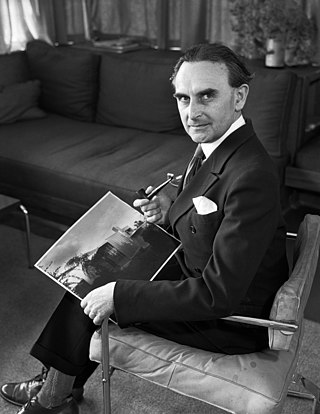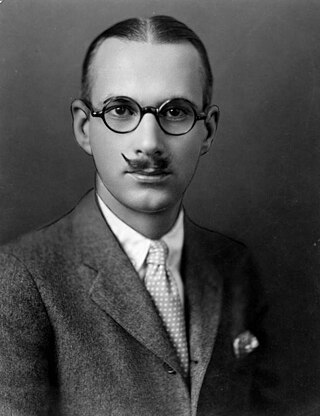
Richard Joseph Neutra was an Austrian-American architect. Living and building for most of his career in Southern California, he came to be considered a prominent and important modernist architect. His most notable works include the Kaufmann Desert House, in Palm Springs, California.

Mediterranean Revival is an architectural style introduced in the United States, Canada, and certain other countries in the 19th century. It incorporated references to Spanish Renaissance, Spanish Colonial, Italian Renaissance, French Colonial, Beaux-Arts, Moorish architecture, and Venetian Gothic architecture.

Morgan, Walls & Clements was an architectural firm based in Los Angeles, California and responsible for many of the city's landmarks, dating back to the late 19th century. Originally Morgan and Walls, with principals Octavius Morgan and John A. Walls, the firm worked in the area from before the turn of the century.
Albert Raymond Walker (1881-1958) was an American architect. He is primarily known for his work with Percy A. Eisen as Walker & Eisen in Los Angeles.
Roland Coate was an American architect. He designed many houses and buildings in California, three of which are listed on the National Register of Historic Places.
Silas Reese Burns (1855–1940) was an American architect.

Abraham Wesley Eager (1864–1930) was a Canadian-born American architect. He designed many houses in Los Angeles, California.

Sumner Spaulding (1892–1952) was an American architect and city planner. He is best known for designing the Harold Lloyd Estate, a.k.a. Greenacres, in Beverly Hills, California, the Catalina Casino in Avalon on Santa Catalina Island, California, and the Malaga Cove Plaza in Palos Verdes Estates, California.
Douglas Honnold was an award-winning Canadian-born American architect. He designed many residential properties and commercial buildings in Los Angeles, California. He won an Honor Award from the Southern California Chapter of the American Institute of Architects in January 1947 for his design of the Embassy Shop in Beverly Hills alongside architect John Lautner. He turned down the offer to design the famous McDonald's golden arches.
George Vernon Russell was an American architect. He designed many residential properties and commercial buildings in Los Angeles, California. He also designed the masterplans and a library unit for the University of California, Riverside as well as the 1976 expansion of the Natural History Museum of Los Angeles County.
Lyman Farwell was an American architect and politician. As the co-founder of the architectural firm Dennis and Farwell, he designed many buildings in Los Angeles County, including The Magic Castle. He also served in the California State Assembly.

Julian Medical Building, also known as the Owl Drug Store Building, is a historic two-story building at 6384 W. Hollywood Boulevard, on the corner of Hollywood and Cahuenga Boulevard, in Hollywood, California.
The Hollywood Post Office, also known as Old Post Office, was a historic building located at 1717 N. Vine Street in Hollywood, California.
Hollywood's Artisan's Patio Complex, also known as Artisan Patio, is a historic one-story building complex located at 6727-6733 W. Hollywood Boulevard.

Norman Walton Alpaugh (1885–1954) was a Canadian architect known for his work in and around Los Angeles, California.

John Montgomery Cooper (1885–1954) was an American architect known for his work in and around Los Angeles, California. The city of Santa Monica considers him "a successful local architect with an accomplished career... [that] did not reach the level of Master Architect."
Fisher, Lake & Traver was an architecture firm based in Fresno and Los Angeles, California. It was the successor to Shields, Fisher and Lake, based in Fresno. Three of their buildings have been entered into the National Register of Historic Places.
Oliver Perry Dennis was an American architect. As co-founder of the architectural firm Dennis and Farwell, he designed many buildings in Los Angeles County, California, including the Hollywood Hotel, Janes House, and the Magic Castle. He also designed or co-designed several buildings in Tacoma, Washington.

Richard Douglas King (1879–1945) was an American architect known for his work in southern California.










